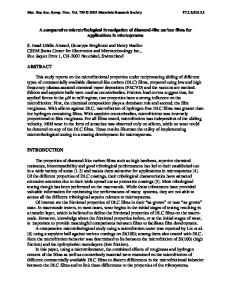A comparative microtribological investigation of diamond-like carbon films for applications in microsystems
- PDF / 673,955 Bytes
- 6 Pages / 612 x 792 pts (letter) Page_size
- 106 Downloads / 295 Views
J13.2.1/ Y7.2.1
A comparative microtribological investigation of diamond-like carbon films for applications in microsystems S. Imad-Uddin Ahmed, Giuseppe Bregliozzi and Henry Haefke CSEM Swiss Center for Electronics and Microtechnology Inc., Rue Jaquet Droz 1, CH-2007 Neuchâtel, Switzerland ABSTRACT This study reports on the microfrictional properties under reciprocating sliding of different types of commercially available diamond-like carbon (DLC) films, prepared using low and high frequency plasma-assisted chemical vapor deposition (PACVD) and the vacuum arc method. Silicon and sapphire balls were used as counterbodies. Friction-load curves suggest that, for applied forces in the µN to mN regime, two properties have a strong influence on the microfriction: First, the chemical composition plays a dominant role and second, the film roughness. With silicon against DLC, microfriction of hydrogen-free DLC films was greater than the hydrogen containing films. With sapphire counterbodies, microfriction was inversely proportional to film roughness. For all films tested, microfriction was independent of the sliding velocity. Mild wear in the form of scratches was observed only on silicon, while no wear could be detected on any of the DLC films. These results illustrate the utility of implementing microtribological testing in a coating development for microsystems.
INTRODUCTION The properties of diamond-like carbon films such as high hardness, superior chemical resistance, biocompatibility and good tribological performances has led to their established use in a wide variety of areas [1-3] and makes them attractive for applications in microsystems [4]. Of the different properties of DLC coatings, their tribological characteristics have attracted extensive attention due to their wide spread use as protective coatings [5]. Most tribological testing though has been performed on the macroscale. While these tribotesters have provided valuable information for optimizing the performances of many systems, they are not able to access all the different tribological aspects relevant to microsystems. Of interest are the frictional properties of DLC films in their “as-grown” or near “as-grown” state. In macroscale testers, in most cases, wear begins in the initial stages of testing resulting in a transfer layer, which is believed to define the frictional properties of DLC films on the macroscale. However, knowledge about the frictional properties before, or at the initial stages of wear, is important to provide meaningful comparisons between films to facilitate film development. A comparative microtribological study using a microfriction tester was reported by Liu et al. [6] using a sapphire ball against various coatings on Si(100); among them also coated with DLC. Here the microfriction behavior was determined to lie between the microfriction of Si(100) (high friction) and the hydrophobic monolayers (low friction). In this paper, using a microtribometer, the combined effects of roughness and hydrogen content of the films as well as co
Data Loading...











